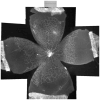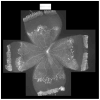Increased angiogenic factors associated with peripheral avascular retina and intravitreous neovascularization: a model of retinopathy of prematurity
- PMID: 20457980
- PMCID: PMC3682829
- DOI: 10.1001/archophthalmol.2010.65
Increased angiogenic factors associated with peripheral avascular retina and intravitreous neovascularization: a model of retinopathy of prematurity
Abstract
Objectives: To determine expression of vascular endothelial growth factor (VEGF), pigment epithelium-derived factor, and their respective receptors in retinas using a model of retinopathy of prematurity.
Methods: Retinas isolated from a 50/10 oxygen (inspired oxygen cycled between 50% oxygen and 10% oxygen every 24 hours)-induced rat model of retinopathy of prematurity (50/10 OIR model), and from room air-raised rat pups (RA) at birth, age 14 days (persistent peripheral avascular retina in the 50/10 OIR model and complete retinal vascularization in RA) and age 18 days (intravitreous neovascularization in the 50/10 OIR model) were analyzed for messenger RNA of VEGF(164), neuropilin 1, neuropilin 2, VEGF receptor 1, VEGF receptor 2, pigment epithelium-derived factor, and pigment epithelium-derived factor receptor by real-time polymerase chain reaction.
Results: In the 50/10 OIR model compared with RA, fold changes in expression of VEGF(164), neuropilin 1, and neuropilin 2 were significantly increased at ages 14 and 18 days. A trend for increased fold change was noted in expression of VEGF receptor 2 at age 14 days and a significant increase at age 18 days in the 50/10 OIR model compared with RA. Pigment epithelium-derived factor receptor was significantly increased at age 14 days in the 50/10 OIR model compared with RA.
Conclusion: Increased expression of VEGF(164) and angiogenic receptors were found in association with both avascular retina at day 14 and intravitreous neovascularization at day 18 in a relevant model of retinopathy of prematurity.
Clinical relevance: Increased VEGF and angiogenic receptors may have a role in the development of peripheral avascular retina and stage 3 retinopathy of prematurity.
Figures









Similar articles
-
Expression of vascular endothelial growth factor and pigment epithelial-derived factor in a rat model of retinopathy of prematurity.Mol Vis. 2011;17:1577-87. Epub 2011 Jun 10. Mol Vis. 2011. PMID: 21738387 Free PMC article.
-
Association of retinal vascular endothelial growth factor with avascular retina in a rat model of retinopathy of prematurity.Arch Ophthalmol. 2010 Aug;128(8):1014-21. doi: 10.1001/archophthalmol.2010.158. Arch Ophthalmol. 2010. PMID: 20697002 Free PMC article.
-
VEGF isoforms and their expression after a single episode of hypoxia or repeated fluctuations between hyperoxia and hypoxia: relevance to clinical ROP.Mol Vis. 2004 Jul 21;10:512-20. Mol Vis. 2004. PMID: 15303088 Free PMC article.
-
Studies on the pathogenesis of avascular retina and neovascularization into the vitreous in peripheral severe retinopathy of prematurity (an american ophthalmological society thesis).Trans Am Ophthalmol Soc. 2010 Dec;108:96-119. Trans Am Ophthalmol Soc. 2010. PMID: 21212851 Free PMC article. Review.
-
The effects of oxygen stresses on the development of features of severe retinopathy of prematurity: knowledge from the 50/10 OIR model.Doc Ophthalmol. 2010 Feb;120(1):25-39. doi: 10.1007/s10633-009-9181-x. Epub 2009 Jul 29. Doc Ophthalmol. 2010. PMID: 19639355 Free PMC article. Review.
Cited by
-
Quantitative analyses of retinal vascular area and density after different methods to reduce VEGF in a rat model of retinopathy of prematurity.Invest Ophthalmol Vis Sci. 2014 Feb 4;55(2):737-44. doi: 10.1167/iovs.13-13429. Invest Ophthalmol Vis Sci. 2014. PMID: 24425858 Free PMC article.
-
Safety and Efficacy of Systemic Anti-Scg3 Therapy to Treat Oxygen-Induced Retinopathy.Front Biosci (Landmark Ed). 2022 Apr 19;27(4):130. doi: 10.31083/j.fbl2704130. Front Biosci (Landmark Ed). 2022. PMID: 35468689 Free PMC article.
-
Effect of VEGF trap on normal retinal vascular development and oxygen-induced retinopathy in the dog.Invest Ophthalmol Vis Sci. 2011 Jun 8;52(7):4039-47. doi: 10.1167/iovs.10-6798. Invest Ophthalmol Vis Sci. 2011. PMID: 21357392 Free PMC article.
-
Targeting Müller cell-derived VEGF164 to reduce intravitreal neovascularization in the rat model of retinopathy of prematurity.Invest Ophthalmol Vis Sci. 2014 Feb 10;55(2):824-31. doi: 10.1167/iovs.13-13755. Invest Ophthalmol Vis Sci. 2014. PMID: 24425851 Free PMC article.
-
A review of treatment for retinopathy of prematurity.Expert Rev Ophthalmol. 2019;14(2):73-87. doi: 10.1080/17469899.2019.1596026. Epub 2019 Mar 29. Expert Rev Ophthalmol. 2019. PMID: 31762784 Free PMC article.
References
-
- Neufeld G, Kessler O. The semaphorins: versatile regulators of tumour progression and tumour angiogenesis. Nat Rev Cancer. 2008;8:632–645. - PubMed
-
- Chan-Ling T, Gock B, Stone J. The effect of oxygen on vasoformative cell division: Evidence that ‘physiological hypoxia’ is the stimulus for normal retinal vasculogenesis. Invest Ophthalmol Vis Sci. 1995;36:1201–1214. - PubMed
-
- Oosthuyse B, Moons L, Storkebaum E, et al. Deletion of the hypoxia-response element in the vascular endothelial growth factor promoter causes motor neuron degeneration. Nat Genet. 2001;28:131–138. - PubMed

